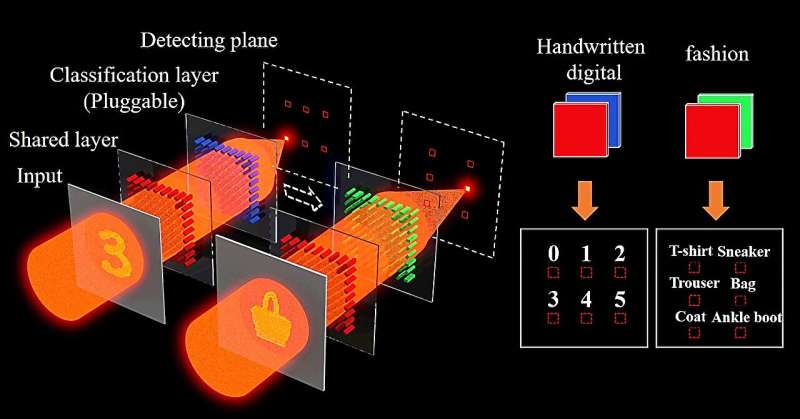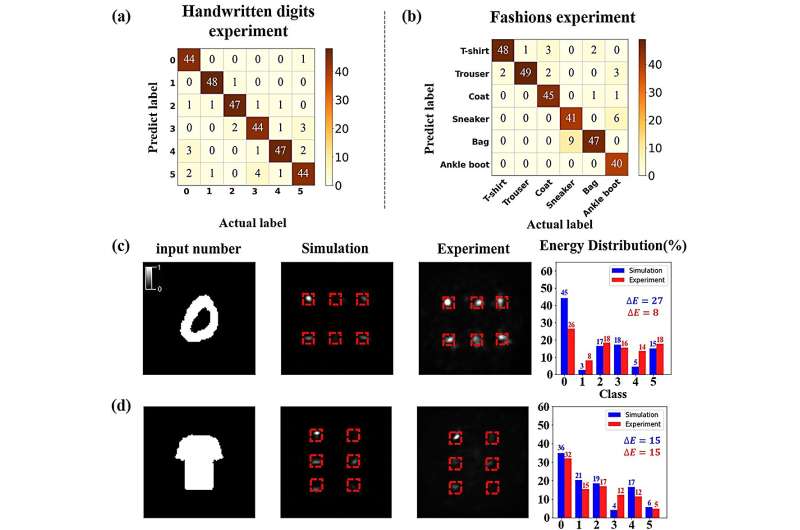This article has been reviewed according to Science X's editorial process and policies. Editors have highlighted the following attributes while ensuring the content's credibility:
fact-checked
proofread
Pluggable diffractive neural networks based on cascaded metasurfaces

Deep learning algorithms based on artificial neural networks are completely changing information processing methods in many scientific and engineering fields.
Currently, it has been applied to many specific tasks, including image classification, image encryption, speech recognition, and language translation. However, With the rapid development of artificial intelligence algorithms, there is a huge contradiction between the computing power required by artificial neural networks and the computing power provided by electronic chips.
The slowdown of Moore's Law in the "post-Moore era" and the limitations of von Neumann architecture have resulted in high energy consumption and time consumption issues for existing computing architecture.
With the advantages of high computing speed, high parallelism, and low energy consumption during transmission, the diffractive neural networks with light as the medium can simulate the artificial neural networks for high-speed computing, providing a solution to the problem of computing power and energy consumption.
Recently, all-optical diffractive neural networks have been implemented and validated in imaging processing and object recognition. Diffractive neural networks are typically constructed by several diffractive layers, with each unit structure inside being viewed as a neuron, and the interconnections between neurons across different layers are realized through light diffractive.
Diffractive neural networks have been widely researched in various tasks, including image recognition, linear matrix operations, logical operations, and beam shaping.
Currently, diffractive neural networks are usually implemented in the terahertz and microwave bands, but it is still difficult to achieve integration miniaturization and lack of reconfigurability. Compared with traditional diffractive optical elements, metasurfaces are more compact in the optical band and can be used to simultaneously control the amplitude and phase of light by changing the shape, size, and arrangement of the meta-atoms inside the metasurfaces. The implementation of diffractive neural networks using metasurfaces helps to obtain miniaturized intelligent integrated optical devices.

The authors of the article, published in Opto-Electronic Advances, propose pluggable diffractive neural networks (P-DNN) to address the reconfigurability issue of diffractive neural networks. Combined with the transfer learning algorithm, the phase parameters of internal plug-ins can be trained, and multiple recognition tasks, such as handwritten digit recognition and fashion recognition, can be achieved by switching the pluggable components in the networks.
As shown in Fig. 1, the modulation layer of the pluggable diffractive neural networks can be divided into two parts: the shared layer for preprocessing input information and the pluggable layer for switching multiple tasks.
The input information is modulated using a specific shape mask, and the incident light is focused onto a sub-detecting area on the detecting plane after passing through the pluggable diffractive neural networks, and the object classification is determined by the energy distribution. In the case of fixed shared layer plug-ins, other recognition tasks can be achieved, such as switching from handwritten digit recognition to fashion recognition.
To validate the effectiveness of the proposed method, the research team designed a two-layer cascaded metasurfaces operating at 800 nm near-infrared band, demonstrating the ability of the pluggable diffractive neural networks for handwritten digit and fashion recognition tasks. The experimental classification accuracies of handwritten digits and fashions classification tasks exceed 91.3% and 90.0%, respectively (Fig.2a, b).
By analyzing the energy distribution in the sub-detecting areas of the detecting plane, when the shared layer plug-in is fixed, the handwritten digit plug-in and the fashion plug-in are used respectively, and the handwritten digits and fashions can be accurately identified according to the energy distribution. (Fig. 2c, d).
The pluggable diffractive neural networks are a universal model that can be applied to various classification tasks, improving the flexibility of networks design while effectively reducing the consumption of computing resources and training time. The good reconfigurability of the pluggable diffractive neural networks provides a solution to the problem of the lack of reconfigurability in diffractive neural networks, and the use of metasurfaces helps to achieve device integration and miniaturization.
In the future, the pluggable diffractive neural networks based on metasurfaces can be used as optical integrated components for different functional AI systems, providing low-energy and high-speed computing for specific tasks, such as real-time object detecting in autonomous driving systems and intelligent optical filtering in microscope imaging.
More information: Cong He et al, Pluggable multitask diffractive neural networks based on cascaded metasurfaces, Opto-Electronic Advances (2023). DOI: 10.29026/oea.2024.230005


















